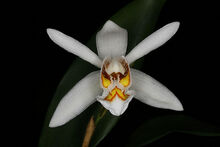| Coelogyne punctulata | |||||||||||||||||
|---|---|---|---|---|---|---|---|---|---|---|---|---|---|---|---|---|---|
| |||||||||||||||||
Coelogyne punctulata is a species of Coelogyne.
Description Edit
Edit
Plants blooms in the spring with ten 2.5 cm wide flowers. Flowers are fragrant with a musky scent.
This species is similar to Coelogyne nitida and Coelogyne occulata but differs by having the inflorescence emerge from the top of a mature growth rather than the base.
Distribution Edit
Edit
Plant is found growing in the montane forest of Nepal, Bhutan, northeastern India, Burma and Yunnan China at elevations around 2200 meters.
Culture Edit
Edit
Plants are usually grown in baskets. Plant grows in cool temperatures and in partial shade. Water regularly during the summer, about once every two days and gradually reduce in the winter. Water about once every two to three weeks and gradually increase watering as new roots begin to show. Pot in a well drain medium. Pot in a plastic or clay pot with a mix of fine fir bark, tree fern fibers, and perlite or pot in New Zealand sphagnum moss.
Naming Edit
Edit
Common name: The Spotted Coelogyne
Synonyms Edit
Edit
- Coelogyne brevifolia Lindl. 1854
- Coelogyne goweri Rchb.f. 1869
- Coelogyne nitida [Roxb.] Hook.f. 1890
- Coelogyne ocellata Lindl. 1833
- Coelogyne ocellata Lindl. var. maxima Rchb.f. 1879
- Coelogyne ocellata Lindl. var. boddaertiana Rchb.f. 1882
- Coelogyne punctulata f. brevifolia (Lindl.) S.Das & S.K.Jain 1980
- Coelogyne punctulata var. hysterantha T.Tang & F.T.Wang 1951
- Cymbidium nitidum Roxb. 1832, nom. illeg.
- Pleione brevifolia (Lindl.) Kuntze 1891
- Pleione goweri (Rchb.f.) Kuntze 1891
References Edit
Edit
- Hill, Cindy. "Coelogyne:Sparkiling Stars of Asia." Orchid Digest Vol. 72-2 April, May, June 2008: 60-76.

Rhizome rigid, stout, 5-7 mm in diam., with brown scaly sheaths. Pseudobulbs rather contiguous, less than 1 cm apart on rhizome, bright yellow when dried, oblong or narrowly ovoid-oblong, 2.5-4 cm × 7-13 mm, with 2 leaves at apex and several sheaths at base; sheaths ovate-oblong, 2-5 cm, papery. Leaf blade lanceolate or narrowly oblong-lanceolate, 8-14 × 1.3-2.5 cm, adaxially often with dense raised transverse veinlets, apex acuminate; petiole 2-4 cm. Inflorescence hysteranthous, slightly recurved, 8-15 cm; rachis 2-4-flowered; floral bracts caducous, suboblong-lanceolate, 2-3.5 cm; pedicel and ovary 13-17 mm. Flowers white, with deep-colored eyelike blotches on lip. Sepals lanceolate or oblong-lanceolate, 18-20 × 4-5 mm, apex acute. Petals linear, 18-20 × ca. 1.5 mm; lip ovate, 16-18 × ca. 10 mm, 3-lobed; lateral lobes erect, nearly suborbicular, apex rounded; mid-lobe ovate-lanceolate, ca. 7 × 5-6 mm, with 2 longitudinal, dentate lamellae extending from base of lip to mid-lobe and a short median lamella between them. Column slightly arcuate, ca. 12 mm, both sides winged; wings widened from base to apex, upper part 1.5-2 mm wide on one side, apex subtruncate or obtuse. Capsule obovoid-oblong, ca. 2.2 × 0.8-0.9 cm. Fl. Nov, fr. next Apr. 2n = 38.
On trees or rocks in forests; 1300-2900 m. S and SE Xizang, W Yunnan [Bhutan, NE India, Myanmar, Nepal].
CITIES category : Appendix II
References
1.Ref 1
2.Ref 2
3.Ref 3

No comments:
Post a Comment